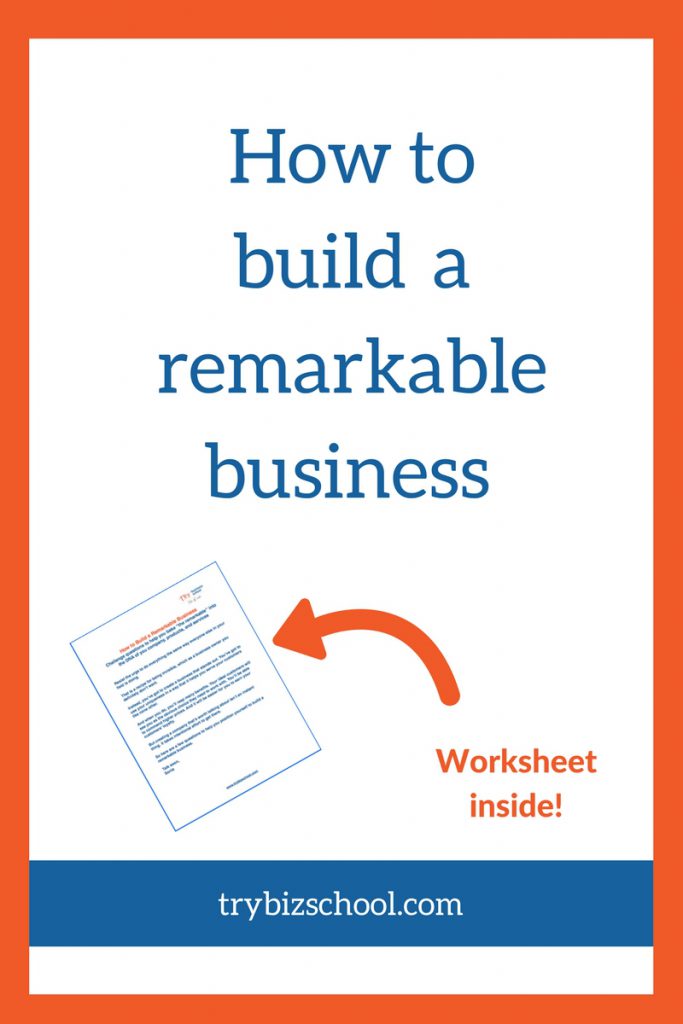“There’s nothing like it in the world!”
Can you say that about your business and the products and services you offer?
Or when you talk about what you do, does it sound the same as a bunch of other businesses in your field?
These days, your ideal customers have a ton of options available to them. And as you work hard to make life better for them, you’ve got to stand out.
You’ve got to make it an easy and obvious choice for them to choose you instead of all those other people who are doing similar things.
And the best way to do that is to figure out how to build a business that is remarkable. When you do, you’ll find it a whole heck of a lot easier to win new customers and earn their loyalty.
Why remarkable should be the standard you strive for
You’ll be invisible if you don’t. At least, that’s 18-time best-selling author Seth Godin’s take on it. He made the case for this concept in his book Purple Cow:
Something remarkable is worth talking about. Worth noticing. Exceptional. New. Interesting. It’s a Purple Cow. Boring stuff is invisible. It’s a brown cow.
Remarkable marketing is the art of building things worth noticing right into your product or service. Not slapping on marketing as a last-minute add-on, but understanding that if your offering itself isn’t remarkable, it’s invisible.
The goal here isn’t to go out and just do crazy, out of the ordinary things just to get attention. Rather, your objective is to bake uniqueness into the DNA of what you do as you serve your customers.
And specifically, you’ve got to do it in a manner that your customers care about.
Here’s an example.
A few weeks ago, I wandered into the Arte Tango shoe shop in my barrio in Buenos Aires. As I was chatting with the owner, I grew more and more interested in his shoes. Every time I asked a question, he explained a different feature that made his shoes different from all the other tango shoes on the market.
That’s when he boldly declared, “there’s no other shoe like this on the market.”
I was so intrigued, I went back and did a quick interview with Ariel, the owner. Here he is explaining why his shoes are so remarkable.
The remarkability of his product offering is built in by design. Custom-made tango shoes. With a flexible sole that isn’t typical of many tango shoes on the market. And with memory foam padding to make the shoes even more comfortable.
The awesomeness just kept getting layered on in my eyes. As a result, I’m plotting in my mind how I can get a pair of Ariel’s shoes (tango shoes ain’t cheap!). 🙂
How to bake remarkability into your business’s DNA
When your uniqueness is intertwined into what you do, then it makes it easier for you to solve your customers’ problems like none other. It makes it easier for you to make your competition irrelevant.
It makes it easier for you to live the good life while getting paid to change the world.
But being remarkable isn’t just as simple as waking up one day and deciding that you’re going to be awesome (although that’s a great place to start).
It’s a process. One that will require you to be intentional about developing the knowledge, expertise, and eye for creating something special.
In essence, being remarkable comes down to one of two things:
- Doing different activities than everyone else in your field
- Doing the same activities in a different way
Here are 4 ways to position yourself to build a remarkable business.
1. Use a compass, rather than a map
In The Art of Being Unmistakable, Srini Rao explained the concept beautifully:
“If I were to use a map long enough, eventually I would become fearful of ditching it for a compass. However, if I want to do interesting work, take risks, and see what I am really made of, I have to be willing to use a compass instead of a map. The day I ditched the map for the compass is the day I walked off the edge of the Earth, and my work became an experience that only I can create for people. Every time I have been given a map, I have gotten lost. The map was based on where somebody else wanted me to end up. By following that map, at best I will become a pale imitation of the person who drew the map.
The thing with using a compass instead of a map is that I don’t know the hurdles, the roadblocks, and potholes that might occur. However, on the unpaved path there is often scenic beauty along the way. Straight and narrow paths rarely lead to interesting destinations.”
This is one of the reasons why there is so much sameness in business. Everyone is following the same map. The same blueprint. The same ideas. And what happens when a bunch of people are on the same road?
Traffic.
I don’t know anyone who likes traffic.
This doesn’t mean that you ignore best practices and frameworks that have been proven to work in favor of feeling your way through everything.
Rather, you should be extracting the important principles from them and then applying your own fingerprint to it to elevate it and make it something that works for you and your situation.
I had a breakthrough in this area recently. Getting over this mindset barrier changed my entire outlook on what’s possible in my business and the things in which I’m able to accomplish.
I’ve embraced this philosophy in life. That’s how I ended up here in Buenos Aires, and learning Spanish, and even dancing tango.
And because of this openness to exploring and a willingness to see what is behind the door that is in front of me, I’ve found lots of new opportunities, surprises, and joy.
When I allow myself to follow my compass in the direction life leads me, rather than forcing myself to follow my “pre-determined” plan, I’m able to innovate. To grow. To reject operating on autopilot. To not be a same old version of everyone else.
And now I’m embracing this approach in my business.
Ditch the roadmap. Break out of the limiting mindset that “this is the way things have to be.”
Then pick up your compass, and explore outside the lines.
2. Embrace opportunities (large and small) to develop and hone your skills
One of my favorite things to do here in Buenos Aires on Sunday’s is to go to the feria de San Telmo, a local street market.
There are artists and selling and showcasing some of everything. This guy was selling crafts:
There are people who bake food in their homes and then bring them out to sell. This guy had homemade stuffed bread.
I even indulged in some homemade street food when I saw a girl selling Colombian-style empanadas.
And there are musicians that come out and play their music.
Everyone can find an audience. And the experience of coming and finding a space and just putting themselves out there is what strikes me as most fascinating.
This is where fearlessness and boldness are developed. This is the essence of entrepreneurship.
A lot of times as business owners, we only want the big, high profile opportunities. But it’s in embracing the experiences and skill development you gain from doing your work in a more indie, grassroots, level, that prepares you for the big time.
It’s what gives you the experiences you need to find out what works and doesn’t work for you. To assess what your ideal customers respond best to. To figure out your strengths and important areas that need improvement.
Bruno Mars (who I adore!) followed this path. Today he is an amazing, remarkable performer, that wows audiences in packed stadiums all over the world. But he developed into the performer that he is by investing time in more humble beginnings early on.
“I’ve been doing shows. I had a full-time job at four. Five nights a week. It was called the Love Notes [his parents’ band]. It was a 1950s doo-wop review type show. And they used to do impersonations of Little Richard, Chuck Berry, Jerry Lee Lewis, Elvis Presley, and I would come out on stage and do my little Elvis impersonation.”
Remember Ariel, the tango shoe designer from earlier? He started making tango shoes when he was 16 and has been doing it for nearly 25 years.
He didn’t always have a remarkable, patented shoe. But through the process of doing the work, in public, over and over again, like Bruno Mars, he was able to create something worth paying attention to in his field.
3. Get inspiration from uncommon places
One of the reasons why so many businesses get stuck in the sea of sameness is because they are too busy following the same people, the same examples, and running in the same circles as everyone else.
Even when they aren’t following the same roadmap.
To do and create remarkable things, you’ve got to seek out different experiences and different points of view.
Steve Jobs was an advocate of this.
If you’re gonna make connections which are innovative, you have to not have the same bag of experience as everyone else does.
Research proves this out as well. One study showed that fashion designers were more creative when they spent time living abroad in places that were significantly different from where they were from where they lived.
The time in new foreign environments forced their minds to problem-solve and view everyday occurrences with different lenses.
Inspiration can come from everywhere. Look at other industries. Look at non-business related things. Make connections from things that seem like they are unrelated, and then figure out how you can use it to your advantage to create something remarkable.
In the 1960’s, Motown was one of the most successful record labels, with iconic groups such as The Jackson 5, The Temptations, and The Supremes signed to it. Founder Barry Gordy and his team produced hit after hit.
But his inspiration for how to turn Motown into the powerhouse music factory that it was, came from an unlikely source:
“He loosely modeled the Motown operation on the most prosperous business model he saw around him – the assembly lines at the many automotive plants in the region. (In fact, Gordy himself had worked in a Ford assembly plant during the 1950s.) Instead of assembling cars, though, he put together hit records.
Gordy adopted the idea of making development a team effort, and, as on an assembly line, each member of the team was given a specialized task to perform. He cultivated a group of experts who, working together, could take unrefined young singers and turn them into hit-makers ready to perform and promote the Motown product: records.”
4. Ask “what if?”
Many breakthroughs start with a simple question:
“What if?”
For eyeglass company Warby Parker, it was “what if we could eliminate the middle man and sell eyeglass frames at a lower price?”
For Toms, the shoe and apparel manufacturer, it was, “what if we could build a business that makes money AND helps people in need at the same time?”
And for organic bedding & luxury sheet company Boll & Branch, it meant asking “what if we could build a company that made the experience of buying sheets better?”
All of these entrepreneurs asked this defining question. And going down the rabbit hole to answer how to do it led them to building multi-million dollar businesses.
Be aware, this process isn’t always so easy. Scott Tannen, co-founder of Boll & Branch explains:
“If you want to disrupt a category that has been unchallenged for generations, you have to be brave. We’re not simply selling products at a lower cost, we have had to undo and rebuild just about every aspect of textiles production, going against the not-so-great status quo. At Boll & Branch, we’ve redefined the very notion of category disruption. We’ve not just changed the quality:price ratio in bedding and home textiles, but we have fundamentally disrupted the basic way in which the industry operates.”
This defining question can change everything for you. Instead of marching down the path of doing what has already been done with just a few minor tweaks, it helps you go down the path of creating something that demolishes the status quo in a big way.
But before you can make asking this question work for you and your business, you’ve got to believe that you are capable of making what you dream about a reality. You can’t let your present circumstances, abilities, or current frame of reference deter you.
In his book It’s Not How Good You Are, It’s How Good You Want to Be, Paul Arden put it this way:
“Firstly you need to aim beyond what you are capable of.
You must develop a complete disregard for where your abilities end.
Try to do the things that you’re incapable of.
If you think you’re unable to work for the best company in its sphere, make that your aim.
If you think you’re incapable of running a company, make that your aim.
If you think you’re unable to be on the cover of Time magazine, make it your business to be there.
Make your vision of where you want to be a reality.
Nothing is impossible.”
It’s time for you to build a remarkable business
The benefits are numerous.
You make your competition irrelevant. Your ideal customers choose you and are eager to work with you. You can charge premium prices for your expertise. And you make life better for your customers.
It’s a win-win-win all around.
But as with most things that are worth it, it isn’t easy. It takes time. It takes courage. And it takes a commitment to going down the alternate path, even when you’re not sure where you’ll come out on the other side.
But you can do it. I know that you can!
It’s time for you to put your unique fingerprint on the work that you do.
So evict the notion of being an invisible brown cow.
And let’s get to work on building something worth talking about.
To help you hit the ground running applying these 4 lessons, I’ve created a worksheet for you to help you along. Grab it here:










